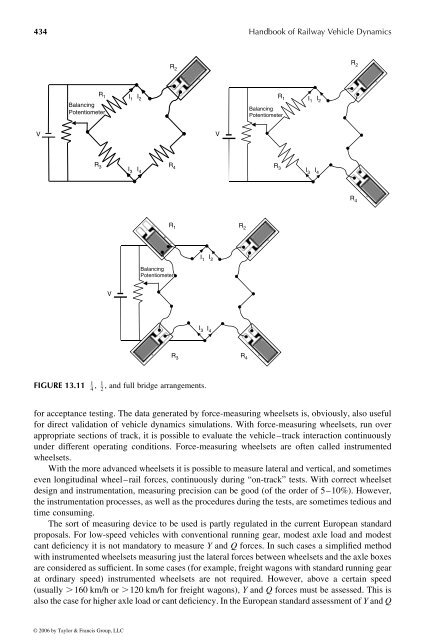Create successful ePaper yourself
Turn your PDF publications into a flip-book with our unique Google optimized e-Paper software.
434<br />
V<br />
R 3<br />
R 1<br />
Balancing<br />
Potentiometer<br />
FIGURE 13.11 1<br />
4<br />
I 1 I 2<br />
I 3 I 4<br />
R 2<br />
R 4<br />
for acceptance testing. The data generated by force-measuring wheelsets is, obviously, also useful<br />
for direct validation <strong>of</strong> vehicle dynamics simulations. With force-measuring wheelsets, run over<br />
appropriate sections <strong>of</strong> track, it is possible toevaluate the vehicle–track interaction continuously<br />
under different operating conditions. Force-measuring wheelsets are <strong>of</strong>ten called instrumented<br />
wheelsets.<br />
With the moreadvanced wheelsetsitispossible to measurelateral and vertical,and sometimes<br />
even longitudinal wheel–rail forces, continuously during “on-track” tests. With correct wheelset<br />
design and instrumentation, measuring precision can be good (<strong>of</strong> the order <strong>of</strong> 5–10%). However,<br />
the instrumentation processes, as well as the proceduresduring the tests, are sometimes tedious and<br />
time consuming.<br />
The sort <strong>of</strong> measuring device to be used is partly regulated in the current European standard<br />
proposals. For low-speed vehicles with conventional running gear, modest axle load and modest<br />
cant deficiency it is not mandatory to measure Y and Q forces. In such cases asimplified method<br />
with instrumented wheelsetsmeasuring just the lateral forces betweenwheelsets and the axle boxes<br />
are considered as sufficient. In some cases (for example, freight wagons with standard running gear<br />
at ordinary speed) instrumented wheelsets are not required. However, above acertain speed<br />
(usually . 160 km/h or . 120 km/h for freight wagons), Y and Q forces must be assessed. This is<br />
also the case for higher axle load or cant deficiency.Inthe European standardassessment <strong>of</strong> Y and Q<br />
© 2006 by Taylor & Francis Group, LLC<br />
V<br />
R 1<br />
Balancing<br />
Potentiometer<br />
R 3<br />
I 1 I 2<br />
I 3 I 4<br />
1 , 2 ,and full bridge arrangements.<br />
V<br />
R 2<br />
R 4<br />
<strong>Handbook</strong> <strong>of</strong> <strong>Railway</strong> <strong>Vehicle</strong> <strong>Dynamics</strong><br />
R 3<br />
R 1<br />
Balancing<br />
Potentiometer<br />
I 1 I 2<br />
I 3 I 4<br />
R 2<br />
R 4









